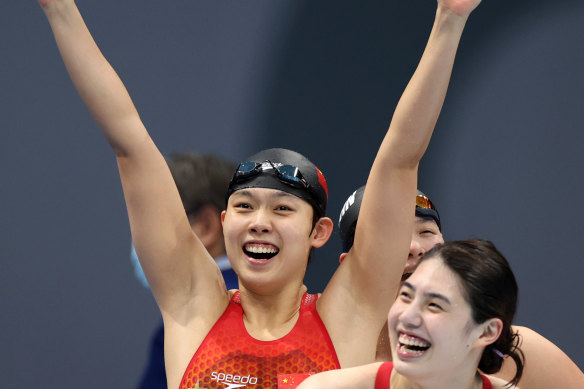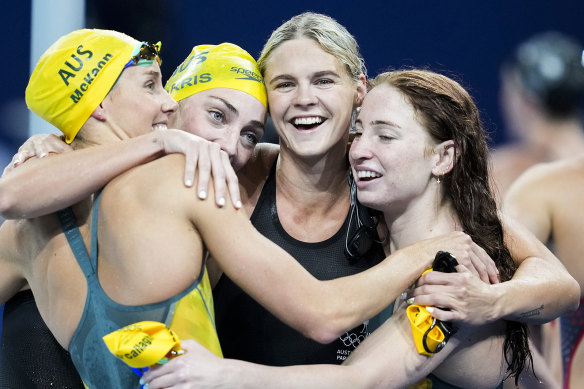- Analysis
- Sport
- Paris 2024
The swimmer and her dodgy Quarter Pounder: Inside the latest Chinese doping scandal
The revelation that Tang Muhan, a member of China’s world-beating women’s 4X200m relay team, secretly tested positive to a banned steroid nearly two years ago is as welcome as a Polly Waffle in La Défense Arena pool.
But, if you pause to consider without prejudgment the facts we know, this latest scandal should bolster rather than weaken athlete confidence in the anti-doping system.

Tang Muhan (arms raised) celebrates with her relay teammates after winning gold at the Tokyo Olympics in 2021.Credit: Al Bello
There is certainly a problem here.
Tang’s positive test for metandienone, recorded within a few months of three other Chinese athletes from as many sports, was not publicly declared by China’s anti-doping agency (CHINADA) or its global regulator, the World Anti-Doping Agency (WADA), until it was dug up this week by another fine piece of investigative reporting by The New York Times.
The way that anti-doping is supposed to work, Tang’s failed drug test and the fact she served a provisional, year-long suspension while CHINADA investigated her case should have been publicly declared once a finding was made.
For reasons that neither CHINADA nor WADA have adequately explained, a powerful sporting nation with a history of systemic doping is not meeting the reporting requirements of the World Anti-Doping Code.
We saw it in the way CHINADA handled the positive tests to Trimetazidine by 23 national level swimmers in late 2020 and early 2021 and again, we can see it here.
Unless national anti-doping agencies provide transparency, you can’t expect athletes to trust them.
Beyond this failing, CHINADA has approached the metandienone cases with a level of diligence and common sense every athlete should hope for if they ever find themselves in Tang’s shower clogs.
Metandienone is a synthetic steroid used in beef production, particularly in Russia, as a cheaper alternative to boldenone and nandrolone. Athletes who test positive to it face a four-year ban.
Tang had just turned 19 when she tested positive to the substance in October 2022. Her story is that it most likely entered her system after she ate a contaminated burger at a McDonald’s restaurant. Fellow swimmer He Junyi tested positive the same day.
CHINADA’s initial response was by-the-book. It provisionally suspended them both, warned them they were looking at four years out of their sport, and began investigating.
The concentration of metandienone detected in both samples was tiny. WADA, in a statement released on Tuesday, indicated it was in the range of a picogram (one trillionth of a gram) per millilitre of urine.
This is comparable to the concentration of the banned SARMs metabolite found in Shayna Jack’s system in 2019. US anti-doping boss Travis Tygart, a fierce critic of WADA, has consistently accepted in cases before his agency that concentration levels this small tend to suggest contamination rather than deliberate doping.
There is something else you should know about Tang and her dodgy Quarter Pounder.

Shayna Jack (second from right) celebrates with teammates (from left) Emma McKeon, Meg Harris and Mollie O’Callaghan after winning gold in Paris on Saturday.Credit: Ashley Landis
Neither McDonald’s nor any global food companies screen for impurities at levels this small. This is because, as Professor Mario Thevis of the German Sport University Cologne, told a Court of Arbitration of Sport (CAS) hearing into Jack’s case, such a dose is “pharmacologically irrelevant”.
In other words, even if Tang deliberately took the substance, she would have received no performance benefit.
A tiny concentration isn’t, on its own, enough to get an athlete accused of doping off the hook, but CHINADA’s investigation found other evidence consistent with contamination, rather than cheating.
At the time Tang provided her sample to drug testers, she was preparing to compete at China’s short-course national championships. According to WADA, she was tested days either side of her positive test and tested negative.
Even allowing for the possibility of microdosing, this suggests her exposure to metandienone was fleeting.
CHINADA did a deep dive into China’s meat supply and found dozens of positive results for metandienone. While this doesn’t prove contamination, it adds weight to the theory.
Tang and He’s defence was further bolstered in early 2023, when a BMX rider and a competitive shooter tested positive to trace amounts of the same substance. It is one thing for a cheating swimmer to take a banned steroid. It is less clear why a shooter would be on the juice.
Although it appears that Tang did not ultimately prove where the metandienone came from, she got closer than Jack, who spent two years and a personal fortune trying to establish how Ligandrol got into her system around the time of an Australian training camp in Cairns.

US anti-doping boss Travis Tygart is a longtime critic of WADA.Credit: Getty Images
Jack served a two-year ban despite successive CAS hearings concluding she did not knowingly or deliberately take a banned substance.
Jack has won a gold medal in Paris and is part of the Australian relay team that will take on China on Thursday. Her involvement at these Games is a story of perseverance. It is hypocritical to hold Tang to a different standard.
The difference between this scandal and the case of the 23 Chinese swimmers is best measured in the five hours it took Tygart to fire off his initial, outraged statement and then, a second, more measured response.
WADA has launched its own investigation into the use of metandienone in the global meat industry. Meanwhile, rivals tempted to point the bone at Tang should understand that, under current anti-doping rules, one trip to the wrong Macca’s can end their career.
WADA’s statement ended with a dig at its critics. “The politicisation of anti-doping continues with this latest attempt by the media in the United States to imply wrongdoing on the part of WADA and the broader anti-doping community,” it read.
“As we have seen over recent months, WADA has been unfairly caught in the middle of geopolitical tensions between superpowers but has no mandate to participate in that.”
WADA’s attempt to portray itself as a victim is risible. On what we know, it is right for Tang Muhan to be at these Games. If CHINADA and WADA were doing their jobs properly, we would have known this a lot earlier.
Sign up for our Sports Newsletter to get Olympic Games updates and general sport news, results and expert analysis straight to your inbox.